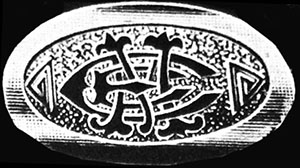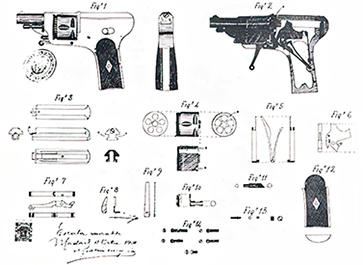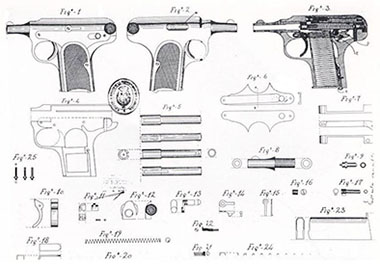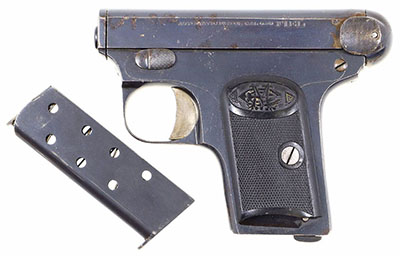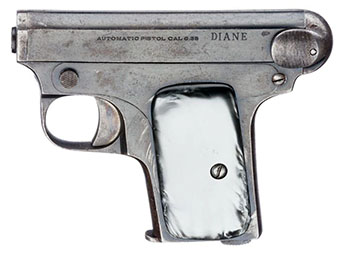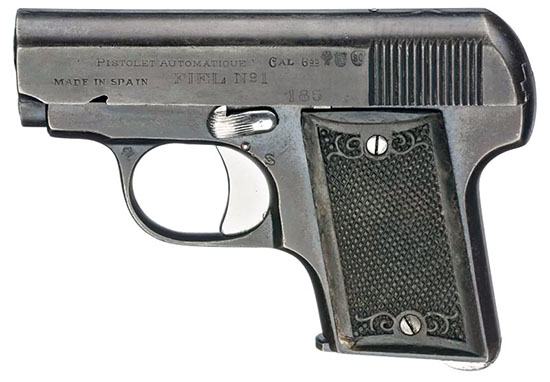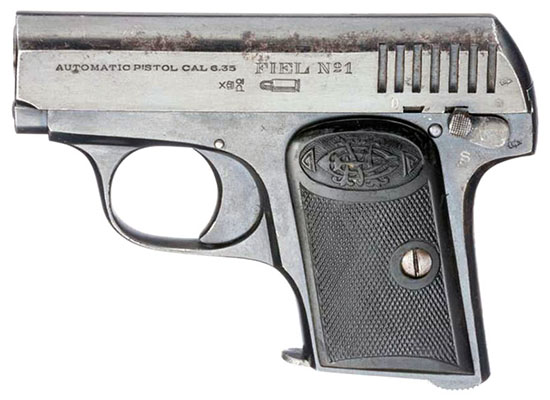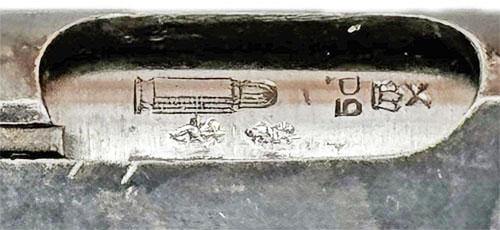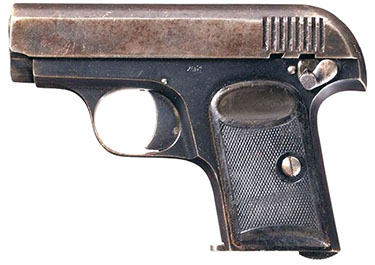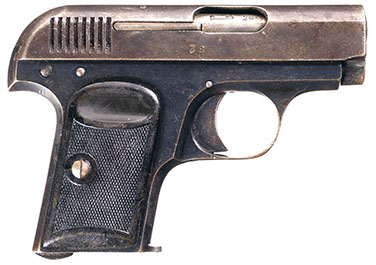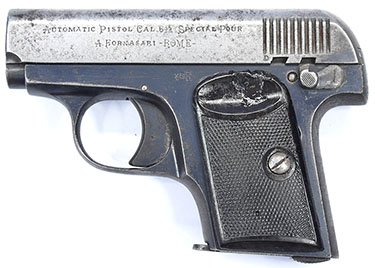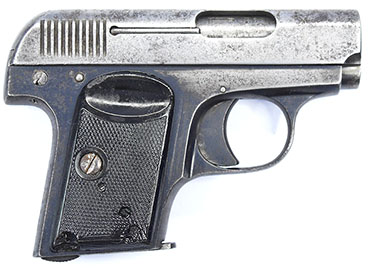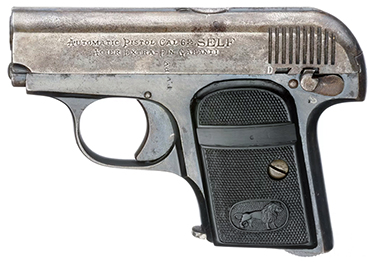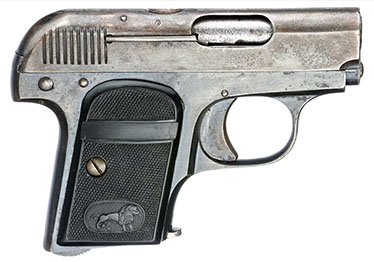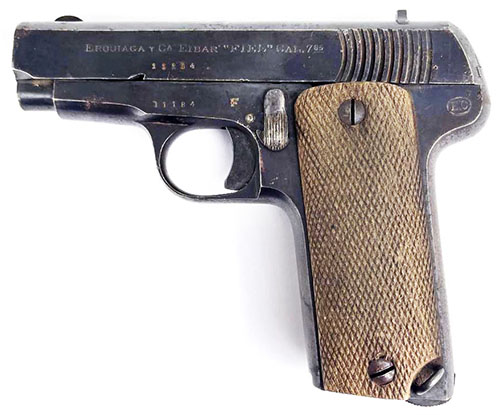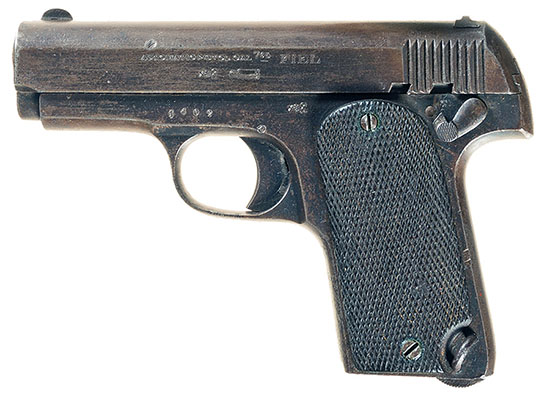 |
|||||||||||||||||||||||||||||||||||||||||||||||||||||||||||||||||||||||||||||||||||||||||||||||||||||||||||||||||||||||||||||||||||||||||||||||||||||||||||||||||||||||||||||||||||||||||||||||||||||||||||||||||||||||||||||||||||||||||||||||||||||||||||||||||||||||||
|
Pistols of by Ed Buffaloe
The founders of Erquiaga, Muguruza y Compañía were Martín Erquiaga and José Muguruza. According to Robert Adair, Muguruza left the firm after World War I, probably around 1920-1921. Erquiaga continued the company under the name Erquiaga y Cía. Martín Erquiaga y Lecube was born about 1860 in Mutricu (also spelled Motrico). He was active in Eibar politics as a dedicated socialist, and was well known in the gun making community. Erquiaga spoke on labor issues in his native Basque (Euskara), whereas his Spanish was described as “clumsy and laborious.” In addition to his work as a guild member and gunsmith, he also owned a tavern in Eibar that was popular with union members and for which his mother served as cook. He was elected to the Eibar city council in 1931 on the socialist ticket.
Erquiaga patented a five shot “automatic revolver” in 1909 (Spanish patent № 46484), looking much like the various velodog style guns of the day. On 1 July 1912 he was among the group of councillors who signed the motion by Pedro Goenaga recommending that the city establish “a School of Armoury, Drawing, Arts and Trades in Eibar, which would also be a permanent exhibition of the town's products, an Armoury Museum and a section of unexploded models of foreign-made weapons,” ultimately to be known as La Escuela de Armería, and for which Erquiaga was soon to serve as a member of the board of directors. The Armory School was the first vocational school in Spain, which still exists in Eibar to this day. Likely in his late 70’s, Martín Erquiaga evacuated to Bilbao during the Spanish civil war, where he died in 1936. Almost nothing is recorded about José Muguruza, other than his name. There was a Niceto Muguruza Larriña (1882-1920), who studied medicine in Zaragoza and Madrid, became a prominent doctor in Eibar, and was known for his work in preventing tuberculosis among the industrial laborers of the city. Perhaps he was related to José in some way. Juan Calvó says that the Eibar Industrial Register shows that Erquiaga, Muguruza y Cía.had two workers in 1913 and five in 1914 and 1915. Clearly, it was a modest enterprise. However, considering the number of weapons eventually produced, they must have had more staff in later years. Based on information in Antaris’ Astra Firearms, it is likely the company fell into the category of small firms having ten to twenty workers, but further information is lacking. Despite having only five workers in 1914, Erquiaga, Muguruza y Cía. participated in the 1914 Eibar Exposición Regional Vasca de Arte y de Industrias Guipuzcoanas. Their entry in the guide says that their “installation of revolvers and pistols is much visited” and that “the specialty of this house is the manufacture of the renowned Fiel brand of automatic pistols.” “Fiel” means “faithful” or “true” in Spanish. Since chronology is difficult to establish with certainty, this article will treat the guns by caliber.
6.35 mm Marte-Fiel-Diane Pistol
Apparently, the first automatic pistol made by Erquiaga, Muguruza y Cia.was designed by one Miguel Culla y Suso, who patented the weapon under the name “Marte” in 1909 (Spanish patent 46062). According to Calvó, the gun was first manufactured in 1912 and was sold under the trade names “Fiel” and “Diane.” The gun featured an original design but, judging from its extreme scarcity today, was made in small quantities.
Based on the patent and known photographs, the Marte-Fiel-Diane was a striker fired single action pistol with a likely magazine capacity of seven or possibly eight rounds. A long bolt runs in a housing on top of the frame, with the recoil spring in a longitudinal cavity just above it. A sideplate on the left side covers the lockwork. The barrel is only about 40 millimeters long, and appears to have been reduced in length by about one-half from that shown in the patent. An innovation that was likely added by Erquiaga is a lever or button at the left front, not shown in the patent, which serves as a quick release for the barrel, allowing it to be easily removed for cleaning. The patent shows a safety lever at the rear which is not observed in existing specimens. The guns are marked on the left side, in all capital serif letters, either: AUTOMATIC PISTOL CAL. 6.35 FIEL or AUTOMATIC PISTOL CAL. 6.35 DIANE
There is a single observed example of an Erquiaga “Ruby” style 6.35 mm pistol, with the safety lever above the trigger, marked “Fiel No. 1.”
This gun, with serial number 185, has fifteen triangular-cut slide serrations, German proofs, and features a standard disconnector that pushes the transfer bar down when the slide is out of battery. Stocks are generic checked horn, with two screws. Hogg and Weeks state that Erquiaga made “Ruby” style 6.35 mm pistols with the brand name “Marte” and featuring EMC monogram stocks. However, the only “Marte” pistols observed have either generic stocks, or stocks featuring the MB monogram of Martín Bascarán. No “Marte” pistols have been observed that can be definitively tied to Erquiaga. While Marte pistols are usually marked “AUTOMATIC PISTOL CAL 635,” so are virtually all of the other Spanish “Ruby” type vest pocket pistols, so this inscription alone is not sufficient to identify them as a product of Erquiaga.
Most known examples of the Fiel No. 1 have the safety lever at the rear of the frame. Most also feature the Erquiaga bullet trademark.
The Fiel No. 1 is hammer-fired and disassembles like a browning. The transfer bar is on the left side. Disconnection after firing is accomplished by camming the transfer bar down against a curved surface in the frame cutout on the left side, but there is no mechanism to prevent firing if the slide is out of battery. The manual safety lever, which locks the hammer, is of an unusual external design not seen on other brands, and serves to lock the slide both for safety and cleaning. The safety lever is tensioned by a spring and plunger inserted from the bottom right side and secured by a screw. The slide inscription reads: AUTOMATIC PISTOL CAL 6.35 FIEL No 1
The Fiel No. 1 pistol is rust blued and has checkered horn grip plates with the EMC monogram in an oval at the top. The magazine release is unusual in that it does not rotate on an axis but slides back and forth smoothly. There are seven flat-bottom plunge milled slide serrations on each side. Other examples have eight or ten serrations, a bit closer together. The slide has two cuts for the safety lever; the rearmost cut is intended to lock the slide when the safety is engaged; the forward cut is to lock the slide open for disassembly and has a small “D” just in front of it. There is an “S” on the frame beneath the safety. There are some small ersatz proof marks on the left side of the frame and on the barrel, visible in the ejection port. Also visible in the ejection port, and sometimes on the left side of the gun, is the bullet trademark of Erquiaga, Muguruza y Cia.
Examples of the Fiel No. 1 are known with no inscription at all or with trade name inscriptions, including “A. Fornasari” and “SELF,” and usually featuring generic horn or hard rubber stocks.
The A. Fornasari slide inscription reads: AUTOMATIC PISTOL CAL 635 SPECIAL POUR
The SELF slide inscription reads: AUTOMATIC PISTOL CAL 635 SELF 7.65 mm Pistols Nine Shot “Ruby” Type 7.65 mm Fiel Pistol
Antaris states that Erquiaga produced about 15,000 ‘Ruby’ type pistols during World War I. Hogg states that the company was a subcontractor for Gabilando. These are typical “Ruby” pistols with curved slide serrations and the safety lever above the trigger. The magazine of the 7.65 mm Erquiaga “Ruby” Fiel has a capacity of nine rounds. The gun is marked on the left side: ERQUIAGA Y CA EIBAR “FIEL” CAL, 765 The letters “EC” are stamped in an oval at the rear. Magazines are also stamped “EC” and have eight holes on each side for viewing cartridges. (Because magazines from different manufacturers were often not interchangeable, the magazines were usually stamped to match the gun.) The magazine release is of the rotating type common on Ruby pistols. The gun features a lanyard ring at the bottom of the left grip frame. All observed examples have checked wooden stocks. Seven-Shot 7.65 mm Fiel The seven-shot 7.65 mm Fiel is an enlarged version of the 6.35 mm Fiel No. 1, with the same distinctive safety lever at the rear, the bullet logo on slide and barrel, and the sliding magazine release, but with ten triangular-cut slide serrations. It also features a lanyard ring at the bottom of the left grip frame. All observed examples have checked wooden stocks. It seems likely that these guns were made during the war for direct sale to France, but firm evidence is lacking.
The gun is marked in all capital serif characters: AUTOMATIC PISTOL CAL765 FIEL 7.65 mm Fiel No. 2 Robert Adair displays an advertisement for a 7.65 mm Fiel No. 2, dating from around 1921. The gun illustrated is clearly a 6.35 mm, so the illustration is almost certainly an artist’s rendering. A pistol like this has not been observed, but a post on a Spanish gun forum indicates that a 7.65 mm Fiel No. 2 surfaced in Spain in 2007. No photograph was available, however. |
|||||||||||||||||||||||||||||||||||||||||||||||||||||||||||||||||||||||||||||||||||||||||||||||||||||||||||||||||||||||||||||||||||||||||||||||||||||||||||||||||||||||||||||||||||||||||||||||||||||||||||||||||||||||||||||||||||||||||||||||||||||||||||||||||||||||||
|
|||||||||||||||||||||||||||||||||||||||||||||||||||||||||||||||||||||||||||||||||||||||||||||||||||||||||||||||||||||||||||||||||||||||||||||||||||||||||||||||||||||||||||||||||||||||||||||||||||||||||||||||||||||||||||||||||||||||||||||||||||||||||||||||||||||||||
|
Copyright 2023-2024 by Ed Buffaloe. All rights reserved. |
|||||||||||||||||||||||||||||||||||||||||||||||||||||||||||||||||||||||||||||||||||||||||||||||||||||||||||||||||||||||||||||||||||||||||||||||||||||||||||||||||||||||||||||||||||||||||||||||||||||||||||||||||||||||||||||||||||||||||||||||||||||||||||||||||||||||||
|
|
|||||||||||||||||||||||||||||||||||||||||||||||||||||||||||||||||||||||||||||||||||||||||||||||||||||||||||||||||||||||||||||||||||||||||||||||||||||||||||||||||||||||||||||||||||||||||||||||||||||||||||||||||||||||||||||||||||||||||||||||||||||||||||||||||||||||||
|
|
|||||||||||||||||||||||||||||||||||||||||||||||||||||||||||||||||||||||||||||||||||||||||||||||||||||||||||||||||||||||||||||||||||||||||||||||||||||||||||||||||||||||||||||||||||||||||||||||||||||||||||||||||||||||||||||||||||||||||||||||||||||||||||||||||||||||||
